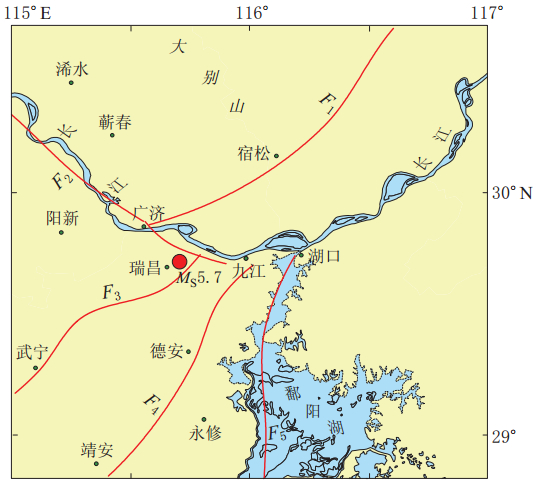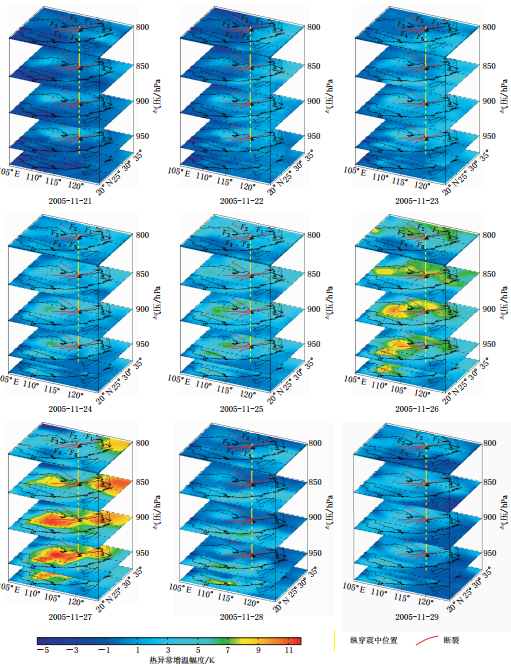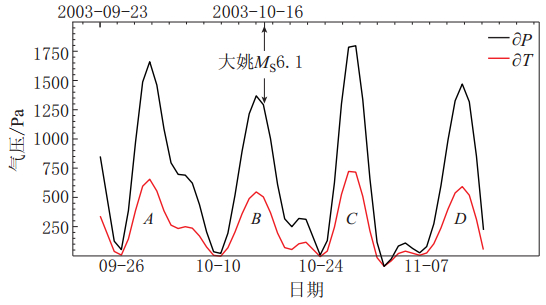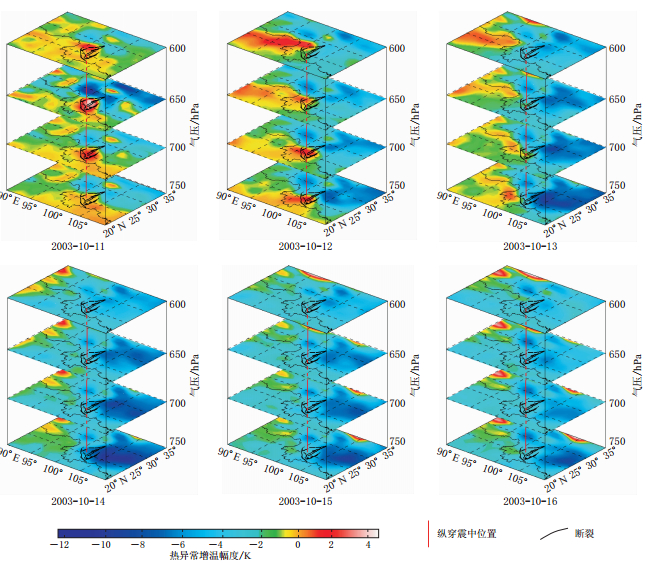Spatio-temporal dynamic variation of thermal anomalies before and after the 2005 Jiujiang MS5.7 earthquake based on the modulation of additive tectonics stress induced by tide-generating force
-
摘要: 通过利用发震区域的天体引潮力附加构造应力变化模型, 研究了2005年11月26日江西九江MS5.7地震发震构造与天体潮汐引力的关系, 并利用该模型结合美国国家环境预报中心多源综合温度数据资料, 分析了九江地震前后发震区域热异常在时空上的动态变化特征. 结果显示, 一方面, 在时间序列变化上, 孕震区热异常表现出的起始—消亡演变过程与岩石在应力加载下的形变—破裂过程相吻合. 无论近地表大气还是上附多层大气, 热异常主要集中在活动断裂带及其附近区域, 与构造断裂带分布相一致; 同时, 热异常从近地表到高空消失的垂向分布, 符合地面对大气加热导致大气升温→抬升→扩散→消亡的大气动力学基本特性, 表明构造运动是本次温度异常变化的主控原因. 另一方面, 热异常变化遵循引潮力(低值—高值—低值)的变化过程, 显示出天体引力对发震断层温度异常识别具有一定的指示意义以及引潮力可能对构造应力处于临界状态的发震断层具有诱震作用, 预示利用引潮力附加构造应力与热异常变化相结合研究短临地震预测具有一定价值.Abstract: A variation model of additive tectonics stress caused by celestial tide-generating force was put forward to explain its relationship with seismic fault sliding.By applying the model, we analyzed spatio-temporal dynamic evolution characteristics of thermal anomaly based on the multi-source temperature data from National Center for Environmental Prediction (NCEP) of USA before and after the MS5.7 earthquake in Jiujiang, China on November 26, 2005. The results indicate that, on one hand, the evolution of thermal anomaly from initial growth to extinction coincided with the process of rock under the stress from deformation to breaking in time series. The areas of temperature increasing either in near-surface atmospheric layer or in the multi-layers above distributed mainly in active fault zones and their vicinities, which is agreement with the distribution of tectonic fault zones. Furthermore, the vertical distribution of thermal anomaly from near-surface to upper air went through the following stages: atmospheric warming caused by surface heating→lifting→diffusion→disappear, which accords with the basic characteristics of atmospheric dynamics, indicating that tectonic movement was the main cause of the change in the temperature anomalies. On the other hand, the abnormal variations of temperature followed the cyclical change (low-high-low) of tide-generating force, which showed that the astro-tidal triggering had a particular indicative significance for the identification of temperature anomaly on seismic faults, and it could trigger an earthquake when the tectonic stress was in critical status. It indicated that the method of combining additive tectonics stress caused by tide-generating force with thermal anomaly change could be used for the studies of short-impending earthquake prediction.
-
Keywords:
- thermal anomaly /
- vertical structure /
- additive tectonics stress
-
-
图 1 2005年九江MS5.7地震构造图F1: 庐江—广济断裂; F2: 襄樊—广济断裂; F3: 丁家山—郎君山—桂林桥—武宁断裂;F4: 九江—靖安断裂; F5: 湖口—新干断裂
Figure 1. Map showing seismogenic structures in Jiujiang MS5.7 earthquake area F1: Lujiang-Guangji fault; F2: Xiangfan-Guangji fault; F3: Dingjiashan-Langjunshan-Guilinqiao-Wuning fault; F4: Jiujiang-Jing’an fault; F5: Hukou-Xin’gan fault
-
李传友, 曾新福, 张剑玺. 2008. 2005年江西九江5.7级地震构造背景与发震构造[J]. 中国科学: D辑, 38(3): 343-354. Li C Y, Zeng X F, Zhang J X. 2008. The tectonic settings and seismogenic tectonics of the M5.7 Jiujiang earthquake in 2005, Jiangxi Province, China[J]. Science in China: Series D, 38(3): 343-354 (in Chinese).
马未宇, 徐秀登, 徐保华, 郑栋, 卢福水. 2006. 九江地震NCEP异常增温和天体引潮力附加构造应力变化初步研究[J]. 科学技术与工程, 6(13): 1761-1764. Ma W Y, Xu X D, Xu B H, Zheng D, Lu F S. 2006. Using the astro-tidal-triggering and the NCEP temperature increase abnormal information to analyze the earthquake of Jiujiang[J]. Science Technology and Engineering, 6(13): 1761-1764 (in Chinese).
屈春燕, 单新建, 马瑾. 2007. 地震活动热红外异常的影响因素分析[J]. 地震研究, 30(2): 113-119. Qu C Y, Shan X J, Ma J. 2007. Influence factors to seismic thermal infrared anomaly[J]. Journal of Seismological Research, 30(2): 113-119 (in Chinese).
Andrew A T, Masashi H, Oleg A M. 2002. Thermal IR satellite data application for earthquake research in Japan and China[J]. J Geodyn, 33(16): 519-534.
Arun K S, Vineeta R, Priyanka B, Swapnamita C, Santosh K P, Sudipta D, Das J D. 2008. Satellite detection of earthquake thermal infrared precursors in Iran[J]. Nat Hazards, 47(1): 119-135.
Gorny V I, Salman A G, Tronin A A, Shilin B V. 1988. The Earth's outgoing IR radiation as an indicator of seismic activity[J]. Proc Acad Sci USSR, 301(1): 67-69.
Heaton T H. 1975. Tidal triggering of earthquakes[J]. Geophys J R astr Soc, 43(2): 307-326.
Kilston S, Knopoff L. 1983. Lunar-solar periodicities of large earthquakes in southern California[J]. Nature, 304(5921): 21-25.
Kalnay E, Kanamitsu M, Kistler R, Collins W, Deaven D, Gandin L, Iredell M, Saha S, White G, Woollen, Zhu Y, Chelliah M, Ebisuzaki W, Higgins W, Janowiak J, Mo K C, Ropelewski C, Wang J, Leetmaa A, Reynolds R, Jenne R, Joseph D. 1996. The NCEP/NCAR 40-year reanalysis project[J]. Bull Amer Meteor Soc, 77(3): 437-471.
Ma W M, Ma W Y, Zhao H, Li H. 2008. Temperature changing process of the Hokkaido (Japan) earthquake on 25 September 2003[J]. Nat Hazards Earth Syst Sci, 8(5): 985-989.
Ma W Y, Zhang X C, Dai X F, Xie F. 2007. A preliminary study on the use of NCEP temperature images and addictive tectonic stress from astro-tidal triggering to forecast short-impending earthquakes[J]. Earthquake Research in China, 21(1): 85-93.
McNutt S R, Beavan R J. 1981. Volcanic earthquakes at Pavlof Volcano correlated with the solid earth tide[J]. Nature, 294(5842): 615-618.
Mogi K. 1984. Fundamental studies on earthquake prediction[G]//A Collection of Papers of International Symposium on Continental Seismicity and Earthquake Prediction (ISCSEP). Beijing: Seismological Press: 619-652.
Ouzounov D, Freund F. 2004. Mid-infrared emission prior to strong earthquakes analyzed by remote sensing data[J]. Adv Space Res, 33(3): 268-273.
Tramutoli V, DiBello G, Pergola N, Piscitelli S. 2001. Robust satellite techniques for remote sensing of seismically active areas[J]. Ann Geofis, 44(2): 295-312.
Tramutoli V, Cuomo V, Filizzola C, Pergola N, Pietrapertosa C. 2005. Assessing the potential of thermal infrared satellite surveys for monitoring seismically active areas: The case of Kocaeli (Izmit) earthquake, 17 August 1999[J]. Remote Sens Environ, 96(3/4): 409-426.
Wu L X, Liu S J, Wu Y H, Wang C. 2006. Precursors for rock fracturing and failure-Part Ⅱ: IRR T-curve abnormalities[J]. Int J Rock Mech Min, 43(3): 483-493.





 下载:
下载:




